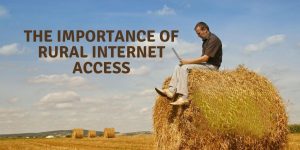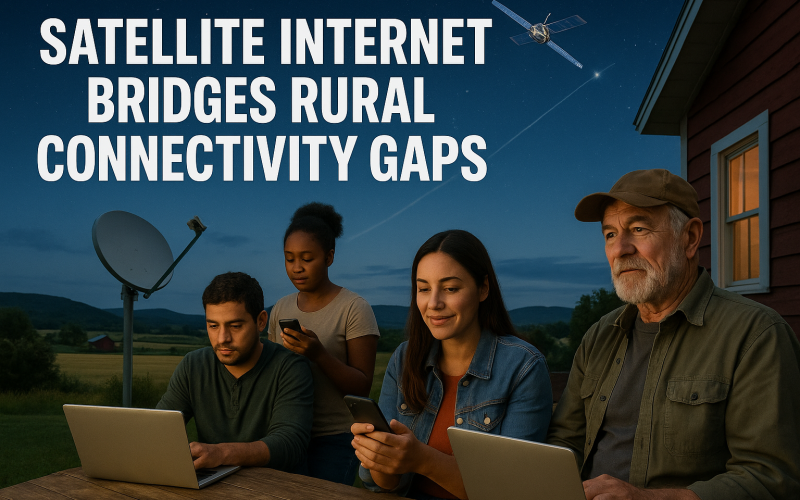Introduction
Many people living in small towns or farmlands do not have reliable internet. This lack of service makes it hard to work from home, attend online classes, or run a small business. Traditional cable internet or fiber options often do not reach these remote spots. Here is where satellite internet service comes in. It uses satellites in the sky to beam internet signals to homes and farms on Earth. For rural connectivity, this technology offers a fresh way to stay online.
In this article, you will learn what satellite internet is and why it matters for people who live far from city centers. You will see how satellite broadband services works, its benefits, and the challenges providers face. We will also explore how this service helps in bridging the digital divide. By the end, you will understand why satellite internet is a game changer for broadband for rural areas.
What Is Satellite Internet?

Satellite internet is a type of broadband that uses signals sent between your home and satellites orbiting Earth. These satellites hover high above the planet, often in geostationary orbit. They stay in a fixed position relative to the Earth’s surface. To connect, you need a small dish on your roof and a modem inside your home. When you click on a website, your request travels from your computer to the satellite, then down to a ground station. The station sends back the website data via the satellite, which delivers it to your dish. This process happens quickly, letting you browse, stream, and chat online.
Originally, satellite internet had slow speeds and high delays. Now, newer satellites and improved technology offer better performance. Companies launch many small satellites in low Earth orbit (LEO). These are closer to Earth than older geostationary satellites. The shorter distance means faster responses, known as low latency connectivity. As a result, users in remote areas get speeds and reliability that nearly match urban options.
Why Rural Areas Need Connectivity

Access to fast, reliable internet is no longer a luxury. It is essential for education, healthcare, and business. In rural connectivity gaps, families struggle to study online or access telehealth. Farmers cannot use smart sensors to track crops. Small businesses miss out on selling products to wider markets. Even local governments face hurdles when they cannot exchange data quickly. With so many daily tasks depending on the internet, rural communities feel left behind.
The phrase bridging the digital divide refers to closing the gap between those who have internet access and those who do not. In many rural places, laying fiber lines is too costly. Sparse populations mean providers cannot recoup investments easily. As a result, large swaths of countryside remain offline or rely on very slow mobile connections. Satellite broadband removes this barrier by delivering service from space to almost any location. This opens up new opportunities for people who once had no choice but to live offline.
How Satellite Internet Works

Satellite internet relies on a few key parts: the satellite, a ground station, a dish, and a modem. Here is a simple overview of remote internet access via satellite:
1. Satellite in Orbit
Satellites orbit Earth at different heights. Geostationary satellites sit about 22,000 miles up. They match Earth’s rotation, so they stay over the same spot. LEO satellites orbit much closer, around 340 to 1,200 miles above the planet. Being closer means they can send data faster with lower delays.
2. Ground Station
A ground station, also called a gateway, connects the satellite network to the wider internet. It links to data centers and routes information to and from online servers. The station must have large antennas that track satellites as they move.
3. Customer Dish
At your home or farm, a small dish mounts on the roof or a pole. This dish points to the right satellite and sends and receives signals. It is often self-aligning or installed by a technician. The dish is weatherproof and can withstand rain, snow, and wind.
4. Modem and Router
The dish connects to a modem inside your building. The modem decodes the satellite signal into internet data. Then, a router shares it with your computer, phone, or smart device via Wi-Fi or Ethernet cables. Some providers include a combined modem-router unit.
5. Data Flow
When you browse a website, your request travels from your device to the router, then to the modem. The modem sends it to the dish, which beams it to the satellite. The satellite relays it to the ground station. The station connects to the internet and retrieves the website. Then, the data returns along the same path to your device.
The satellite ISP manages this entire system. They maintain satellites, ground stations, and customer hardware. Advanced satellite networks add many more satellites to ensure coverage and higher speed. Some networks plan to have thousands of LEO satellites that create a mesh around the globe. This mesh ensures you get a signal even if one satellite operator cannot reach you directly.
Future of Satellite Internet for Rural Connectivity

In the coming years, more affordable and powerful satellites will expand coverage even further. New satellite technologies will reduce weather-related slowdowns and lower latency. Companies may offer unlimited data plans at lower prices, making heavy online use easier. Local communities might build shared hubs where several homes connect to a single dish, cutting costs effective. Overall, satellite fiber internet will keep improving, bringing reliable connections to every corner of the countryside and helping bridge the digital divide.
Comparative Table: Rural Internet Options
| Feature | Satellite Internet | DSL/Cable | Mobile LTE/5G | Fixed Wireless |
|---|---|---|---|---|
| Coverage | Almost anywhere with clear sky view | Limited to areas with phone/cable lines | Covers areas with cell towers | Depends on line-of-sight to towers |
| Installation Cost | Moderate to high (dish, modem, setup) | Low to moderate (existing lines) | Low (SIM card and device) | Moderate (antenna, receiver, setup) |
| Monthly Cost | Moderate to high (varies by plan) | Low to moderate | Low to moderate | Low to moderate |
| Speed Range | 50–200 Mbps (LEO) or 25–100 Mbps (GEO) | 5–100 Mbps | 10–200 Mbps (5G), 5–50 Mbps (4G LTE) | 25–100 Mbps |
| Latency | 30–50 ms (LEO), 500–600 ms (GEO) | 30–50 ms | 30–100 ms | 30–50 ms |
| Weather Impact | High for GEO, moderate for LEO | Low | Moderate (rain fade can affect towers) | Moderate (rain/fog can reduce signal) |
| Data Caps | Often present, varies by provider | Rare | Varies by plan | Rare |
| Equipment Required | Satellite dish, modem, router | DSL modem/router, cable modem/router | Smartphone, mobile hotspot | Antenna, receiver, router |
| Reliability in Remote Areas | Very high | Low (if no lines) | Moderate (if tower coverage exists) | Moderate (if line-of-sight possible) |
| Best Use Case | Hard-to-reach homes, farms, remote schools | Towns with phone/cable lines | Areas with good cell coverage | Communities near transmission towers |
Conclusion
Satellite internet is changing how people in remote areas connect to the world. It offers rural connectivity where cables connect and towers cannot reach. As satellite broadband technology improves, more families and businesses gain reliable service. This helps students learn, farmers manage crops, and local shops sell globally. While higher latency and weather effects remain challenges, new LEO networks cut these issues. With growing competition and government support, prices will drop, making service more affordable. By bridging the digital divide, satellite options bring fair access to jobs, healthcare, and education. In 2025, satellite internet is no longer a backup; it is a key solution for broadband internet for rural areas.










